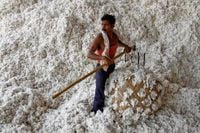India has taken a significant step to address mounting trade tensions with the United States by suspending its 11% import duty on cotton until September 30, 2025. The move, announced late on Monday, August 18, has been interpreted by industry observers and government officials alike as a signal to Washington that New Delhi is willing to address longstanding American concerns over agricultural tariffs. At the same time, the suspension is designed to ease the mounting pressure on India’s sizeable garment and textile industry, which has been reeling under the weight of escalating U.S. tariffs.
According to Reuters, the temporary waiver could offer a double benefit: it provides relief to U.S. cotton growers—who now stand as the second-largest suppliers of cotton to India—and offers a lifeline to India’s apparel sector. The latter faces an imminent crisis, as tariffs on shipments to the United States are set to rise to nearly 60% from later this month. This development comes at a particularly challenging time, with the U.S. market being the largest destination for Indian garment exports.
The suspension of the cotton duty follows a dramatic escalation in trade tensions between the two countries. Earlier in August, President Donald Trump announced an additional 25% tariff on Indian goods, citing New Delhi’s continued purchases of Russian oil as the reason for the punitive measure. This move doubled the total duty on U.S. imports of Indian goods to 50%, a significant jump from the 0-5% levies and 9-13% textile duties that existed prior to the latest round of tariff increases in April.
The fallout has been immediate and severe for India’s labor-intensive export sectors. Textiles, footwear, engineering goods, and shrimp—industries that collectively employ millions—have been jolted by the sudden shift in U.S. trade policy. As reported by Business Times, garment exporters are particularly vulnerable, with many facing order cancellations and struggling to compete against rivals from Bangladesh and Vietnam, which face U.S. duties of just 20%, and China, at 30%.
Adding to the uncertainty, a planned visit by U.S. trade negotiators to New Delhi, scheduled for August 25-29, was abruptly called off. The cancellation has delayed crucial talks on a proposed bilateral trade agreement and dashed industry hopes for a reprieve from the additional 25% U.S. tariff that is set to take effect from August 27. As a result, many Indian exporters are now scrambling to explore manufacturing options overseas, hoping to offset the impact of the higher tariffs and maintain access to the U.S. market.
The numbers tell a stark story. India’s cotton imports more than doubled in the 2024/25 fiscal year ending March 2025, reaching $1.2 billion—up from $579 million just a year earlier. Of this, $234 million worth of cotton was sourced from the United States, according to Ajay Srivastava, founder of the Global Trade Research Initiative in New Delhi. Australia led the pack with $258 million, while Brazil and Egypt supplied $181 million and $116 million, respectively.
Srivastava noted, "The largest beneficiary of the duty free import will be the U.S., the second largest supplier to India," highlighting the mutually beneficial nature of the suspension. India already allows duty-free cotton imports from Australia within a quota, but the new measure broadens the scope, making it clear that the U.S. stands to gain significantly.
Industry bodies such as the Confederation of Indian Textile Industry (CITI) have been vocal in their calls for the government to scrap the cotton import duty altogether, arguing that such a move is essential to maintaining the sector’s competitiveness. The sharp rise in U.S. tariffs comes just as India was emerging as a favored alternative for American garment buyers. With Bangladesh mired in political uncertainty and global brands seeking to diversify their supply chains beyond China, India had appeared poised to capture a larger share of the lucrative U.S. market.
However, the current crisis is threatening to upend these gains. India’s garment sector is already grappling with a persistent labor crunch and limited production capacity—challenges that have only been exacerbated by the prospect of exporters relocating production overseas. This poses a direct challenge to the government’s much-touted "Make in India" manufacturing initiative, which aims to boost domestic production and create jobs.
Some industry officials now expect the government to extend the duty-free cotton import window beyond September 30, 2025, in order to provide continued support to exporters. As reported by Reuters, the uncertainty over tariffs and supply chains has forced many Indian businesses to consider setting up manufacturing operations in countries with more favorable trade terms, a move that could have lasting implications for India’s industrial base.
The broader context of the dispute is a shifting landscape in global trade, where tariffs are increasingly being wielded as tools of economic statecraft. For India, the stakes are high: its labor-intensive sectors are not just economic engines but also vital sources of employment for millions of workers. The U.S. market remains critical, but rising protectionism and the specter of further tariff hikes have prompted Indian exporters to look for alternative destinations for their goods.
Meanwhile, U.S. cotton growers have reason to cheer. With the removal of the 11% import duty—at least temporarily—they are well-positioned to increase their exports to India, one of the world’s largest consumers of cotton. The move also sends a clear message to Washington that India is willing to engage constructively on trade issues, even as political and strategic differences persist.
The situation remains fluid. The cancellation of the U.S. trade delegation’s visit is a setback for those hoping for a quick resolution, and the possibility of further escalation cannot be ruled out. Yet, there is a sense among industry insiders that the Indian government is prepared to make further concessions if necessary, especially if it means preserving the competitiveness of its export sectors and safeguarding jobs.
For now, the suspension of the cotton import duty offers a measure of relief to a beleaguered industry. Whether it will be enough to weather the storm of rising tariffs and shifting trade alliances remains to be seen. What is clear is that both India and the U.S. have much to gain from a stable and mutually beneficial trade relationship—and much to lose if current tensions spiral into a full-blown trade war.
As the deadline for the new tariffs approaches, all eyes will be on New Delhi and Washington. The decisions made in the coming weeks could shape the future of the global textile trade—and the livelihoods of millions on both sides of the world.


